
This section is not about recommending any particular equipment or buying from any companies, but rather about the current equipment that I use and why. I do not endorse or receive any compensation from using the gear that I have. These are just my choices of gear that fits my goals (& pocketbook) for hiking and backpacking.
When I find something that I like I tend to hang onto it for a long time. Back in the early 1980’s I purchased a Sierra Designs tent with their new swift clip system, no more pole sleeves. It was a full 4 season tent, 2 person (slept 3), free standing 8 lb. tent for a whopping $240; an exceptional amount at that time, may have been the last tent I bought at retail. It was a 4-pole system and was absolutely bombproof and never leaked. After 20+ years of use, I gave it to my son when he was in the scouts and in turn, he gave it to a friend of his that was living in the woods in 2018. I guess it finally gave up the ghost shortly thereafter for a total run of around 35 years.
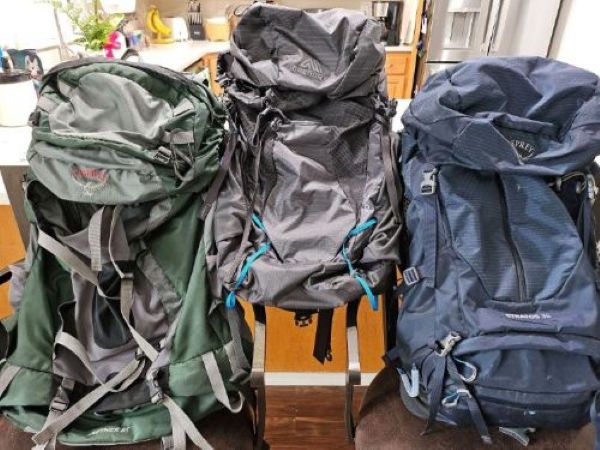 • Backpacks/Daypacks: Fit and comfort is probably my biggest need for a backpack. Many of the newer packs are well made with a lot of features. But as always, try to fit them in the store if possible. If not available in the store, at least try a comparable pack that uses the same frame and harness setup from the same manufacturer.
• Backpacks/Daypacks: Fit and comfort is probably my biggest need for a backpack. Many of the newer packs are well made with a lot of features. But as always, try to fit them in the store if possible. If not available in the store, at least try a comparable pack that uses the same frame and harness setup from the same manufacturer.
Osprey Aether 85: This pack is getting a bit old (~20 yrs), and it is a bit heavier (5 lbs) and larger than needed most of the time, but it is super comfortable for me and can be compressed for smaller loads. It also can carry loads in excess of 55 pounds, but I don't do that anymore. The 475 Bear Vault fits horizontally in the main compartment and I can fit my current solo tents, sleeping bag and some clothes in the lower compartment. This has been a great pack.
Gregory Focal 48: This was a new pack in 2025. I bought this pack for 2-3 day trips instead of using the Osprey 85 which was overkill; and 1/2 the weight (2.5 lbs). I found for me that 3 days is about max for this pack, 48 liters fills fast. I used it on 6 trips over the summer of 2025 and never had a problem with it. For me, it fit really well and was all day comfortable. I had some concern on the really small straps and buckles but I had no failures. On 2 trips the pack doubled as a day pack and it worked well for that role. I opted to use 2 CTUG water bottle holders on the shoulder straps rather than a bladder or multiple bottles inside the pack, which freed up space. I can only effectively fit the small Bear Vault (425) which worked for overnight trips. The BV450 will fit in the pack but not well. I carried between 27 & 35 lbs on my trips.
Osprey Stratos 36: This is my current go-to daypack, although I have several others. Sometimes it is a bit of overkill on the volume, but it has plenty of room for everything I need for a full day. I sometimes take my stove along as a cold sandwich or trail snacks just don't cut it. There is a lot of the state line trail that is dry and I don't always end up at a lake, so I do have the need to carry fluids for the entire day from time to time. I am able to stuff everything I need for a quick overnighter in it, but it is a little overloaded then. My only complaint is that the frame/shoulder harness squeaks at times. From what I read, this is a common complaint with some of the newer Osprey packs.
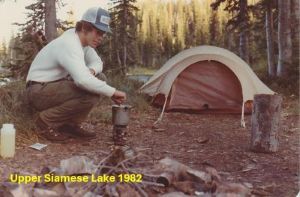 • Tents: Even though a quality tent is a must, I don’t believe you need to spend $500+ on a 3-season 2-person tent and especially $400 on a 1-person tent. Good tents are always on sale, you just need to spend some time researching. Shrinkflation is alive and well in the tent world. The newer tents have definitely shrunk over the years. In the 1980’s I owned a Eureka Caddis 1, as pictured in 1982, that was specifically sold as a 1-person tent that had about the same square feet of floor space as my current 2 person tents. My friend Chuck Bauer also had a 1-person tent that we used for 8 nights in Glacier.
• Tents: Even though a quality tent is a must, I don’t believe you need to spend $500+ on a 3-season 2-person tent and especially $400 on a 1-person tent. Good tents are always on sale, you just need to spend some time researching. Shrinkflation is alive and well in the tent world. The newer tents have definitely shrunk over the years. In the 1980’s I owned a Eureka Caddis 1, as pictured in 1982, that was specifically sold as a 1-person tent that had about the same square feet of floor space as my current 2 person tents. My friend Chuck Bauer also had a 1-person tent that we used for 8 nights in Glacier.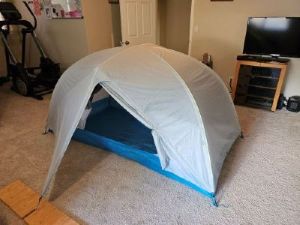
Mountain Hardware Aspect 2: This is a new tent that I bought on sale for 2025 that weighs in at about 3.25 lbs with added footprint. It has 2 doors, 2 vestibles, more headroom and less complicated to set up than the Studio 2 listed below, which it is replacing. I used this tent on 6 trips during 2025 and had no problems. It is a little different as the poles have set hooks and the tent has string loops that attach to the hooks. It is not as slick as the clip systems I have used in the past, but works well and doesn't slow setup. Being a fair weather backpacker these days, I only experienced a little bit of rain and wind and had nothing to cause alarm. It fits 2 people but you need to be friends.
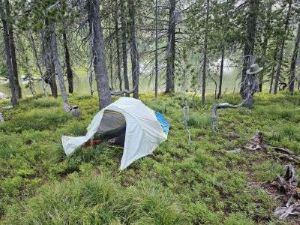
Sierra Designs Studio 2: This tent also weighs in at around 3 lbs. It was been a good tent for my solo journeys. It is really an oversized 1-person tent that fits Skye and myself. It is not free standing, takes a bit to set up and the sides near the foot end of the tent tend to sag a bit allowing some condensation. I have a hard time getting it to be taut enough to avoid that. It is a nice light tent that I paid less than $200 on clearance, but I decided I like a little more headroom and overall space in a tent.
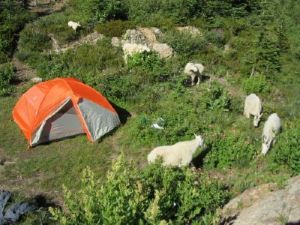
Marmot Tungsten 3P: It is a nice roomy 2-person tent at 7.5 lbs. I doubt that it would actually sleep 3 adults comfortably. It is getting a few years (10+) old but is still a solid tent that works well for 2 people, especially if of larger stature. It is easy to set up and has had a good record for performance and durability.
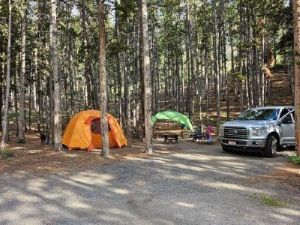
Marmot 6P: This tent is also getting a bit old (15 years) but is still a great tent. I bought it on sale for under $225 as the specific model was being discontinued. We use this for road trips and camping at campgrounds when we don't have the R-Pod with us. For its large profile it really sheds the wind. We had it up in 45+ mph winds in Arches one spring and the wind was hardly noticeable. It will fit 2 queen sized inflatable beds.

RightLine Pickup Bed Tent: I bought this for camping at the trailhead and getting off the ground. It isn’t super high quality, but so far it has held up nicely. I have had it up in significant winds and some good downpours and it hasn't failed. It doesn’t have a floor so it can be set up without emptying the truck bed, which was a good selling point. I have a tonneu cover and it fits great over the partially folder cover so I have a shelf available.
• Stoves and Cooking Gear: My first stove was a Coleman Peak 1 Model 400a. It worked great for many years until the regulator gave out and the entire stove caught fire. I did get the fire out before the entire thing exploded. I paired it with a windscreen and it fit perfectly in the 1.5 quart pot that I used to cook in. I could go several days with just the white gas in the attached tank. I got it to run in -20 degrees one winter day. My friend Chuck Bauer had a little Svea 123 stove and he also got his up and running on that -20 degree day in the headwaters of Lost Creek. I finally moved away from white gas bottles to canisters a number of years ago. I also have a GSI 4-person cookkit that I break out on occasion for car camping or when it is more than just me on a backpacking trip.
I paired it with a windscreen and it fit perfectly in the 1.5 quart pot that I used to cook in. I could go several days with just the white gas in the attached tank. I got it to run in -20 degrees one winter day. My friend Chuck Bauer had a little Svea 123 stove and he also got his up and running on that -20 degree day in the headwaters of Lost Creek. I finally moved away from white gas bottles to canisters a number of years ago. I also have a GSI 4-person cookkit that I break out on occasion for car camping or when it is more than just me on a backpacking trip.
Pocket Rocket paired with the GSI Soloist Pot: This has been a nice solo setup as the pot fits the stove, 8 oz canister and utensils. I normally just boil water for meals and coffee, so this set up is all I need. On long day hikes, I may take the stove and cook a hot meal (well boil water) for lunch. Sometimes sandwiches and trail snacks just don’t cut it. The only downside is that the stove is very susceptible to any kind of wind. I haven't at this time ever had a situation or set up that this was a problem.
MSR Whisperlight: I have had a couple of these over the years. I would take this if more than just myself were on the trip and/or cooking more complex or larger meals that required a bit more than just boiling water.
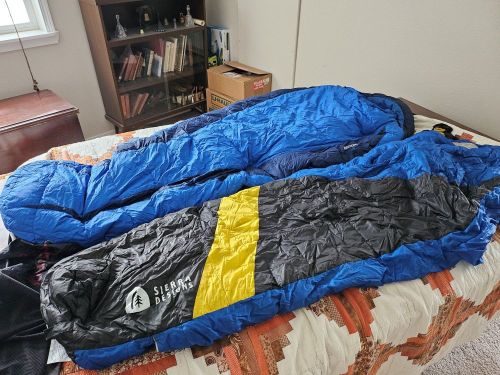 • Sleeping Bags: Much like tents a sleeping bag needs to be of high quality but you can always find good bags on sale. Definitely go with down especially water resistant 800 fill or better down if you can afford it; unless you are strictly car camping and weight or stuffed size is not an issue.
• Sleeping Bags: Much like tents a sleeping bag needs to be of high quality but you can always find good bags on sale. Definitely go with down especially water resistant 800 fill or better down if you can afford it; unless you are strictly car camping and weight or stuffed size is not an issue.
Sierra Designs Cloud 35 w/800 fill: This is a 1.5-pound bag with a zipper-less design that has no fill in the upper back / shoulder area and requires a sleeping pad that fits its provided sleeve; it also has a foot baffle that works great when you get too warm. It is not quite a full-blown quilt, but it is somewhere between a quilt and full zippered bag. This has been a great bag as it is light and warm; almost too warm as I use the clever foot baffle a lot. This seems to be a popular design with Sierra Designs specifically, as I have not found any other manufacturer that has this unique design.
Marmot Sawtooth 15 w/600 fill: This has been a very good bag for over 15 years especially during the fall and spring outings when I need a little more warmth. It is not quite as packable as the Cloud 35 but works well. It is also getting a little old but still functional.
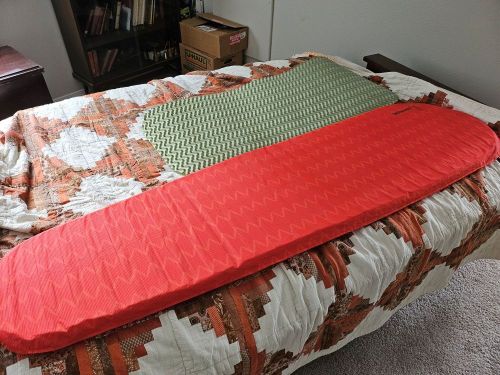 • Sleeping Pads: I have been a Therm-a-Rest fan for many years. I still have my first self-inflating pad from the early 1980’s; the ¾ length standard pad. I have not been sold on the newer air mattresses for a couple reasons. First, I am a restless sleeper and these pads are noisy. I have played with them a bit in the store, and most are noisy. Second, I can’t get past that a hole/leak just leaves you on the ground, at least the Therm-a-Rest has a bit more material. Skye sleeps in the tent with me and her claws could definitely be a puncture hazard. I know many people love them, but I am just not one of them at the moment.
• Sleeping Pads: I have been a Therm-a-Rest fan for many years. I still have my first self-inflating pad from the early 1980’s; the ¾ length standard pad. I have not been sold on the newer air mattresses for a couple reasons. First, I am a restless sleeper and these pads are noisy. I have played with them a bit in the store, and most are noisy. Second, I can’t get past that a hole/leak just leaves you on the ground, at least the Therm-a-Rest has a bit more material. Skye sleeps in the tent with me and her claws could definitely be a puncture hazard. I know many people love them, but I am just not one of them at the moment.
Therm-a-Rest Prolite Apex: I like this pad as the weight (1+ lb) to loft (2 in) ratio works for me. Depending on the situation I can roll it up (folded in half) in it's original bag for inside the pack, or I use the sleeve from the old standard pad for the outside of the pack.
Big Agnes Twister Cane Foam Pad: I sometimes carry this pad in addition to the Therm-a-Rest if I feel I need a bit more comfort, I am getting older. I cut this pad down from the full 6-foot length to 4 feet to save some space and a couple ounces. I took the cut-off 2 feet and further cut it in half for sitting pads that we sometimes take on dayhikes.
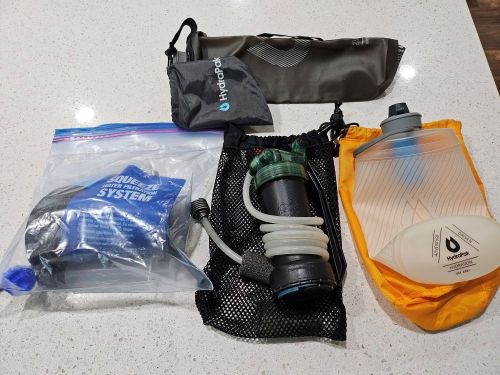 • Water Filters: I have used the MSR Miniworks for years. It is heavy for a filter by today’s standards and a bit slow, but it has been ultra reliable and super easy to use and field clean. I have moved on to a lighter filters that have higher flowrates in the past couple of years but have had mixed results.
• Water Filters: I have used the MSR Miniworks for years. It is heavy for a filter by today’s standards and a bit slow, but it has been ultra reliable and super easy to use and field clean. I have moved on to a lighter filters that have higher flowrates in the past couple of years but have had mixed results.
I tried both the Sawyer & HydraPak filtering systems, but initially both seemed to quit working from one outing to another. The issue that I found is that these non-ceramic filters need to be presoaked before use. I always dry out the filters after a trip, even if it is just a couple days between trips, to avoid any bacterial or mold growth from leaving the filter wet and in storage. I found that if I try to filter water using the dry filter, it doesn’t immediately work and takes several hours to resolve that which is not best when needing to filter on the trail. The MSR miniworks doesn’t need any pre-soaking with its ceramic filter and works immediately. I got used to that over the years and it took me a couple trys to understand the difference.
Now, the day before I plan to use the filter, I fill the water reservoir, leave the valve open and let gravity move the water through the filter for several hours with some occasional pressure applied for encouragement. It takes time for the material to become fully wet and allow water to flow properly. The next day the filter works great for the entire trip. So now I have 3 working filter systems although I am partial to the HydroPak system. For backpacking trips, I bring along a HydroPak 3 liter bag for camp; it packs down small and is lightweight.
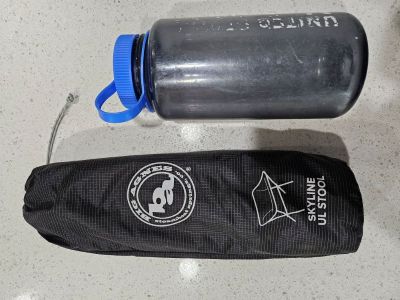 • Big Agnes Skyline UL Stool: I choose the Skyline Stool over a traditional chair for a couple reasons. First, it weighs 1lb. 3 oz. with stuff sack which is lighter than most other chairs that I considered. So weight was a big factor. Second, the stool has a 13-inch seat height; the specs say 15 inches but that is the frame height and not the actual seat height where your butt ends up. The stool is lighter than most of the other backpacking chairs and is taller, easy for an old guy like me to get in and out of. I also found it to be very stable.
• Big Agnes Skyline UL Stool: I choose the Skyline Stool over a traditional chair for a couple reasons. First, it weighs 1lb. 3 oz. with stuff sack which is lighter than most other chairs that I considered. So weight was a big factor. Second, the stool has a 13-inch seat height; the specs say 15 inches but that is the frame height and not the actual seat height where your butt ends up. The stool is lighter than most of the other backpacking chairs and is taller, easy for an old guy like me to get in and out of. I also found it to be very stable.
• Big Agnes Skyline UL Chair: I bought the chair in 2025 and used it on several trips. It weighs in at 1 lb 11oz. Like the UL Stool version which I have had for several years, the effective seat height is 13 inches. Setup is easy and straight forward and once set up it is very stable. The only issue I experienced was that I lost 1 of the rubber footings on a trip. Big Agnes sent me another, although not for free.
I have tried the other chairs in the stores and I can't easily get in or out of them as the functional seat height is more like 8 inches or even less. This is something to consider/measure when looking at chairs since the actual sit height is a couple inches below the stated height of the frame which it seems the manufacturers claim as the seat height. A good test would be to sit on the lowest step on some standard stairs. If you can't do it easily or not at all, I would look at the Skyline UL Stool or Chair.
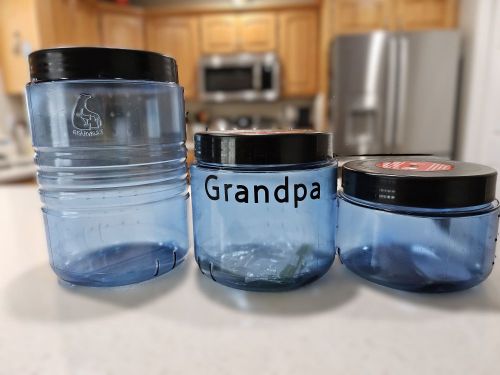 • Food Storage: As kids, we never hung our food when camping in the Great Burn and never had a problem, we were not very bear aware. It wasn’t until we started camping in Glacier Park that we started managing our food storage better.
• Food Storage: As kids, we never hung our food when camping in the Great Burn and never had a problem, we were not very bear aware. It wasn’t until we started camping in Glacier Park that we started managing our food storage better.
The past couple years I have been converting over to the Bear Vault series; I now have the 425, 450, and 475 canisters with the 425 being new for 2025. The 475 (largest) only fits in the Osprey Aether 85, but the 425 & 450 do fit in the Gregory Focal 48. I don’t always use the canisters, so I do hang food on occasion.
I also have an Armored Outdoor Gear small RatSack for Skye's dog food, it is rodent but not bear proof, so I do hang it. The canisters are heavier, but are nice if above or near tree line where finding the right trees is difficult.
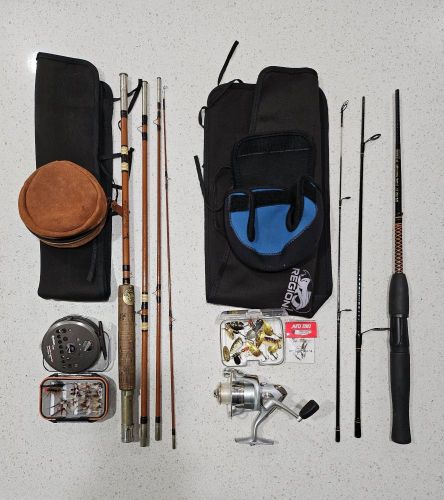 • Fishing: I don’t always plan on fishing when I am out. Many lakes just don't have fish and a good number have marginal fishing, so I just don't bother. Even though I keep both rigs in the truck, I very rarely take both outfits to a lake. I am fairly minimal when it comes to fishing gear. Even though I live in Idaho, I do stay legal and in addition to my Idaho Fishing License I alway purchase a Non-Resident Montana Fishing License. A full season non-resident license is less than $125, good insurance not to pay a big fine.
• Fishing: I don’t always plan on fishing when I am out. Many lakes just don't have fish and a good number have marginal fishing, so I just don't bother. Even though I keep both rigs in the truck, I very rarely take both outfits to a lake. I am fairly minimal when it comes to fishing gear. Even though I live in Idaho, I do stay legal and in addition to my Idaho Fishing License I alway purchase a Non-Resident Montana Fishing License. A full season non-resident license is less than $125, good insurance not to pay a big fine.
My spinning outfit is a 3-piece 5.5 foot “Ugly Stick”, light weight reel and just a dozen or so lures (Thomas, Meps & Panther Martin). My fly rod is a 1960’s Eagle Claw 4-piece 9.5-foot pack rod, lightweight reel, leader material and 15-20 assorted flies. Our dad bought each of us kids and himself one of these rods when I was around 7-8 in the 1960's. In addition, he purchased a combination spinner/fly pack rod.
This is the ONLY fly rod that I have ever owned or used. The accompanying picture represents my lifetime accumulation of fishing gear. I do have a couple old spinning rods and an ancient Garcia Mitchell spinning reel from the 1970's to round things out. I like to fish but I generally don’t worry about how many fish I catch. Most of the lakes in the backcountry that have fish are not very challenging. When you are hooking a fish on almost every cast, a 1960’s fly rod or ugly stick works just as well as an expensive setup.